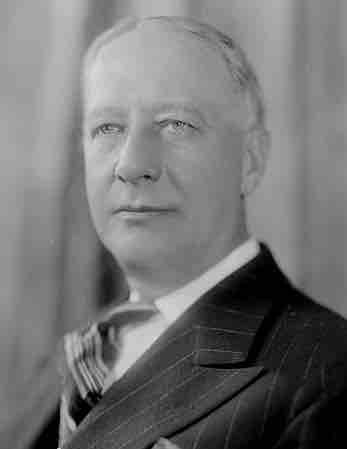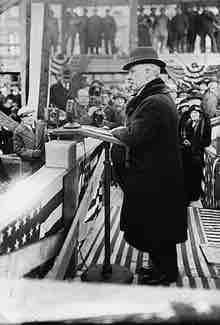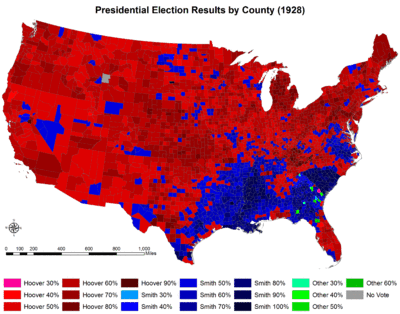Alfred Emanuel "Al" Smith was the Democratic Party’s candidate for president in the election of 1928. A four-time governor of New York, Smith was the foremost urban leader of the efficiency-oriented Progressive Movement, noted for achieving a wide range of reforms as governor in the 1920s. He was also a strong opponent of Prohibition and the first Roman Catholic nominee for U.S. president, which pitted him against Republican Herbert Hoover.
Smith and Hoover
Smith grew up in a struggling New York City family and dropped out of school at age 13 after the death of his father. He never attended high school or college, and claimed he learned about people by studying them at the Fulton Fish Market in the Bronx, where he worked since he was a boy for $12 per week. Prior to leaving school, he was an altar boy and was strongly influenced by the Catholic priests under whom he worked.

Alfred Smith
Democrat Al Smith came from humble beginnings in New York City and rose through the political ranks to become a four-time governor of New York state.
Smith built on his working-class beginnings and identified himself with immigrants and as a man of the people, gaining renown as an excellent speaker. His first political job in 1895 was an investigator in the Office of the Commissioner of Jurors. It was a post appointed by the Tammany Hall organization, the Democratic political machine that played a major role in New York City and New York State politics. While Tammany had gained an infamous name in the mid-19th century for graft and political corruption, Smith’s reputation remained untarnished despite owing much of his political success as a county sheriff, New York City alderman, state assemblyman, and finally governor to Tammany support.
Smith became a leading spokesman for the Irish-American community in the 1920s and was a committed anti-Prohibitionist, or "wet", who attracted millions of voters of all backgrounds, particularly those concerned about the corruption and lawlessness brought about by the Eighteenth Amendment. He first sought the Democratic Party’s presidential nomination at the 1924 election but was one of a number of candidates eventually defeated by John W. Davis, who went on to lose the general election to Republican Calvin Coolidge.

1928 Presidential Candidate Al Smith
Smith was a strong opponent of Prohibition and the first Roman Catholic nominee for U.S. president.
The Republican Party of the 1920s was publicly identified with the thriving economy of the post-World War I period and Herbert Hoover personified that success. A graduate of Stanford University in 1895 with a degree in geology, Hoover served as both a geologist and mining engineer while searching the Western Australian goldfields for Bewick, Moreing & Co., a London-based mining company.
After working in China for a time, Hoover set out on his own as an independent mining consultant. Eventually he had investments on every continent and offices in San Francisco, London, New York City, St. Petersburg, Paris, and Mandalay, Burma. By 1914, Hoover was extremely wealthy, with an estimated personal fortune of $4 million. He was once quoted as saying, "If a man has not made a million dollars by the time he is forty, he is not worth much."
Herbert C. Hoover
Republican Herbert Hoover defeated Al Smith in the election of 1928 to become the 31st President of the United States.
Hoover served as head of the U.S. Food Administration during World War I and then as the United States Secretary of Commerce during the 1920s under Presidents Warren Harding and Calvin Coolidge. He promoted partnerships between government and business under the rubric of "economic modernization."
He was a firm proponent of the Efficiency Movement, which held that the government and economy were riddled with inefficiency and waste, and could be improved by experts who could identify and solve the problems. He also believed in the importance of volunteerism and the role of individuals in both society and the economy. Hoover was the first of two presidents to redistribute his entire salary; John F. Kennedy donated all of his presidential paychecks to charity.
Election of 1928
Smith’s candidacy for president in 1928 mobilized Catholic votes, especially those of women, who had only in recent years gained the legal right to vote. His campaign, however, also caused the Democratic Party to lose the support of the historically safe South by repelling white, conservative Democrats who were staunchly opposed to Roman Catholics.
National prosperity and widespread anti-Catholic sentiment made Hoover’s election inevitable and he won in a landslide over Smith by pledging to continue the economic boom of the preceding Coolidge administration. Smith won the electoral votes of only the traditionally Democratic Southern United States and two New England states with a large proportion of Catholic voters, Massachusetts and Rhode Island. Hoover even triumphed in Smith's home state of New York by a narrow margin.
The inroads made by the Republican ticket in the South were stunning. Texas had never been carried by a Republican before, whereas the electoral votes of North Carolina and Virginia had not been awarded to a Republican since 1872, nor those of Florida since 1876. In all, Smith carried only six of the 11 states of the former Confederacy.

Presidential Election Results by County, 1928
Results by county indicating the percentage for the winning candidate. Shades of red are for Hoover (Republican) and shades of blue are for Smith (Democratic).
Smith attempted the 1932 nomination but was defeated by his former ally and successor as New York governor, Franklin D. Roosevelt. Smith entered business in New York City and became an increasingly vocal opponent of Roosevelt's New Deal.